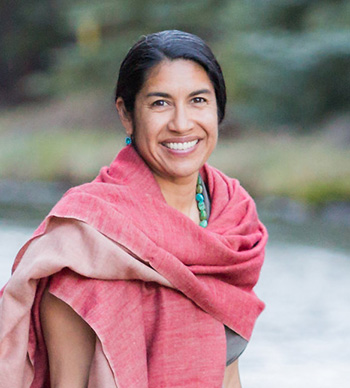With funding from the Howard Hughes Medical Institute (HHMI), biologists at UC Santa Cruz will be using biodiversity surveys and field research to get more students engaged in science.
Beth Shapiro and Erika Zavaleta, both professors of ecology and evolutionary biology, are among a select group of innovators in science education chosen this year for funding through the HHMI Professors Program.
Zavaleta's proposal won her a five-year, $1 million grant to create an inclusive and coordinated pathway that will engage students in ecology and conservation biology and support them all the way through to graduation. The program will provide increased access to research-based field courses and internships, along with sustained mentoring and a supportive community.
"We have so many awesome field courses at UCSC, and I want to make sure they're accessible to a full range of students and link them together into a pathway that will launch a diverse new generation of conservation leaders," Zavaleta said.
Environmental DNA
Shapiro teamed up with Robert Wayne, a molecular ecologist at UCLA, to win a collaborative award of $1.5 million for a program to get large numbers of students involved in biodiversity surveys using environmental DNA. Environmental DNA (eDNA) is a highly sensitive molecular approach for cataloging biodiversity in any ecosystem by analyzing the DNA fragments found in soil and other environmental samples.
"Environmental DNA is both a powerful tool for doing cutting-edge science and a great way to get people interested in science," Shapiro said. "It's fairly easy for a first experience, and yet the range of questions you can address is incredibly broad. It's a gateway to all kinds of different science."
Shapiro and Wayne spearheaded the UC Conservation Genomics Consortium, which Wayne directs, and their HHMI project builds on the consortium's work. Called Environmental DNA for Science Investigation and Education (eSIE), the three-tiered program starts with getting thousands of students involved in initial sampling efforts, either independently, with guidance from online instruction modules and mobile apps, or through organized sampling campaigns called "bioblitzes" at UC Natural Reserves and other sites throughout California. The consortium has been running bioblitzes through its CALeDNA project, and recruitment efforts are already under way to broaden the participation of students, including under-represented groups.
"We want them to go out and have a positive first experience participating in actual field work and collecting samples and data that will be used by scientists, including themselves if they want to keep doing it," Shapiro said.
The second tier of the program will be a biodiversity course designed for both science majors and non-majors, using eDNA as a springboard for increasing science literacy and introducing students to some of the many ways science is relevant to important issues in society. Finally, the program includes funding to support students who want to do independent research projects with faculty mentors.
Field courses
Zavaleta's program aims to build existing field research courses into a more coherent pathway that will guide students interested in ecology and conservation from their freshman or transfer year to graduation. Large introductory lecture courses required early in science majors are often blamed for attrition, and under-represented groups and disadvantaged students drop science majors at much higher rates than other students. Zavaleta said inquiry-based field courses and research opportunities provide experiences that can keep students engaged and inspired.
"By combining the emotional rewards of nature and friendship, shared experience and co-creation, field courses provide the kind of experience that led many, including me, to careers in ecology and conservation biology," she said. "They also create the kind of immersive experience that is so important to learning and is a big part of forming an understanding of the natural world."
Zavaleta wants to lower the barriers that can keep some students from participating in field courses by offering scholarships to cover course fees and building more capacity and diversity among the faculty and graduate students who teach the courses. She also wants to increase opportunities for undergraduates to get research experience through paid internships. A new staff mentorship position will help students take advantage of opportunities such as scholarships and research internships and will provide guidance throughout the program. These efforts will be coordinated and funded through a new Center to Advance Mentored, Inquiry-based Opportunities (CAMINO).
"The idea is to provide wraparound support and build a community for all kinds of students, so we avoid the situation where they get inspired by a great course and then fall of a cliff when they face the big lecture courses required before they can move on," Zavaleta said. "It's also important that we measure and communicate the outcomes of this effort so that we understand what works and can sustain it and scale it up."
The HHMI Professors Program began in 2002, and Manuel Ares, professor of molecular, cell, and developmental biology at UCSC, was among that first cohort of HHMI Professors. This year, out of 177 proposals, only 12 were chosen for funding. In addition to producing two of the funded proposals, UC Santa Cruz submitted four of the 26 finalist proposals that made it through the first two rounds of peer review.




